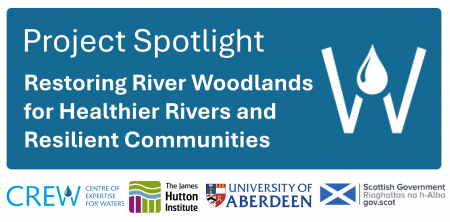News
Restoring River Woodlands for Healthier Rivers and Resilient Communities

Restoring river woodlands, trees and forests alongside rivers, streams and lochs, is gaining momentum across Scotland. These habitats are vital for improving water quality, reducing flood and drought risks, supporting biodiversity, and boosting community wellbeing. Yet over half of Scotland’s riverbanks are in poor condition, and efforts to restore them still face major challenges.
To help address these challenges, a new study funded by the Centre of Expertise for Waters set out to identify which knowledge, tools and actions are needed to support river woodland restoration across the country. Led by researchers from the James Hutton Institute and the University of Aberdeen, the team reviewed a decade of scientific research and engaged over 115 experts and stakeholders from across sectors.
The findings revealed strong support for river woodland restoration, but also highlighted that knowledge is not always being turned into action. Stakeholders pointed to funding gaps, limited collaboration, and a lack of practical guidance as key barriers.
In particular, the study found that while there is good evidence for the benefits of river woodlands in areas like water quality and biodiversity, more research is needed on topics such as tree placement for managing low river flows, selecting drought-resistant species, and understanding public attitudes to restoration. Stakeholders also called for tools that can assess the overall impact of river woodlands, not just single issues.
A workshop held as part of the project brought together experts to prioritise the most pressing knowledge gaps. Top recommendations included better coordination across policies, expanding funding options (including through nature markets), improving long-term monitoring, and increasing knowledge-sharing across sectors.
With researchers combining insights from literature reviews, surveys, workshops, and consultations to produce a final set of recommendations. These outputs aim to guide future investment, research, and restoration efforts. By aligning scientific evidence with stakeholder priorities, the project provides a strong foundation for more coordinated and effective river woodland restoration across Scotland.
This work builds on initiatives such as Riverwoods and aligns with Scotland’s wider environmental goals, including climate adaptation and biodiversity targets. By bridging the gap between evidence and action, it aims to support healthier rivers and more resilient landscapes for the benefit of nature and communities across Scotland.
CREW would like to thank the research team (James Hutton Institute and University of Aberdeen) and the Project Steering Group (SEPA, Scottish Wildlife Trust, Scottish Water, Scottish Forestry, Forest Research, NatureScot, and Scottish Government) for their dedication and support to the project and in addressing this important issue.
View the full project outputs here.




